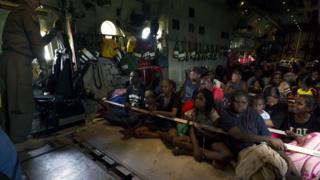Cyclone Trevor: Eyewitness describes the 'guttural howling roar'
 Image copyright
EPA/AUSTRALIAN DEPARTMENT OF DEFENCE HANDOUT
Image copyright
EPA/AUSTRALIAN DEPARTMENT OF DEFENCE HANDOUT
"The noise is probably the most disarming aspect - this guttural howling roar that comes through in waves."
Kristy O'Brien, a journalist for Australian broadcaster ABC, was sheltering in a mining camp near the town of Borroloola when Cyclone Trevor made landfall.
She tells the BBC what it was like to be in the eye of a category four storm, hearing punishing winds and rain squalls outside.
Covering the cyclone
"We caught a plane out here a couple of days ago, ahead of Tropical Cyclone Trevor arriving.
"It was predicted to be very nasty and it lived up to that - it was a category four system which brings winds in excess of 250km/h (155 mph).
"On top of that we had a high tide, which brought in a huge tidal surge, and we've also got localised flooding which could extend for another 500km (310 miles) inland as the tropical system moves through to the centre of Australia."
"It's been organised chaos in some ways. We were here when the defence force brought in several Hercules aircraft, one after the other," she says.
Ms O'Brien and her colleagues were the last people in the town of Borroloola in the Northern Territory - the main town to be evacuated.
It is home to about 900 people, and lies about 50km (31 miles) inland.
"Up to 1,400 people were evacuated from remote coastal communities, and they're all in evacuation centres in Darwin and Katherine - the nearest big towns to here.
"It was seen as too dangerous to keep anyone in the communities," she says. "It'll be some time before they're allowed to come back to their homes because we can't ascertain the damage as yet. It's expected to be quite widespread."
"There will be entire homes and areas flattened by this. We'll have to go in tomorrow once it's safe and once police have been in, to start to get the first pictures out.
"We still have the huge weather system in this region - when you look on a map of Australia it takes up the entire northern half. It's quite phenomenal - it's about 1,000km (621 miles) or so wide."
In the eye of the storm
Ms O'Brien and her team found shelter in the McArthur River mines, about 70km (43 miles) southwest of Borroloola.
"It's an extraordinary feeling to go through something like that. The noise is probably the most disarming aspect - this guttural howling roar that comes through in waves and picks up, while the rain squalls gush through.
"We're in a huge lead and zinc mine, so you kind of wonder what you're going to come out to and what might be flying through the air.
"We were locked inside for hours today. Probably about two hours ago it was finally declared that the core had passed and we were now safe.
"The winds are still strong and it's still raining but that really nasty core of the cyclone where all the danger is is no longer near us.
"We've been allowed to go outside, just within the confines of the mine office. All of the workers have gone out now to assess any damage. Apparently there's quite a few trees down and the power is out so they've gone to work on that.
"We aren't allowed to leave as yet and we don't know when that will be, but we're hoping soon because it's getting quite late into the night now and we've all been up for a while.
"We are keen at some point to hopefully find beds and things!"